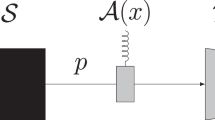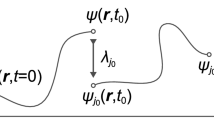Abstract
Randomness is a fundamental feature of nature and a valuable resource for applications ranging from cryptography and gambling to numerical simulation of physical and biological systems. Random numbers, however, are difficult to characterize mathematically1, and their generation must rely on an unpredictable physical process2,3,4,5,6. Inaccuracies in the theoretical modelling of such processes or failures of the devices, possibly due to adversarial attacks, limit the reliability of random number generators in ways that are difficult to control and detect. Here, inspired by earlier work on non-locality-based7,8,9 and device-independent10,11,12,13,14 quantum information processing, we show that the non-local correlations of entangled quantum particles can be used to certify the presence of genuine randomness. It is thereby possible to design a cryptographically secure random number generator that does not require any assumption about the internal working of the device. Such a strong form of randomness generation is impossible classically and possible in quantum systems only if certified by a Bell inequality violation15. We carry out a proof-of-concept demonstration of this proposal in a system of two entangled atoms separated by approximately one metre. The observed Bell inequality violation, featuring near perfect detection efficiency, guarantees that 42 new random numbers are generated with 99 per cent confidence. Our results lay the groundwork for future device-independent quantum information experiments and for addressing fundamental issues raised by the intrinsic randomness of quantum theory.
This is a preview of subscription content, access via your institution
Access options
Subscribe to this journal
Receive 51 print issues and online access
$199.00 per year
only $3.90 per issue
Buy this article
- Purchase on Springer Link
- Instant access to full article PDF
Prices may be subject to local taxes which are calculated during checkout


 , and a confidence level 1 - δ = 99%.
, and a confidence level 1 - δ = 99%.
Similar content being viewed by others
References
Knuth, D. The Art of Computer Programming Vol. 2, Seminumerical Algorithms (Addison-Wesley, 1981)
Jennewein, T., Achleitner, U., Weihs, G., Weinfurter, H. & Zeilinger, A. A fast and compact quantum random number generator. Rev. Sci. Instrum. 71, 1675–1680 (2000)
Stefanov, A., Gisin, N., Guinnard, O., Guinnard, L. & Zbinden, H. Optical quantum random number generator. J. Mod. Opt. 47, 595–598 (2000)
Dynes, J. F., Yuan, Z. L., Sharpe, A. W. & Shields, A. J. A high speed, postprocessing free, quantum random number generator. Appl. Phys. Lett. 93, 031109 (2008)
Atsushi, U. et al. Fast physical random bit generation with chaotic semiconductor lasers. Nature Photon. 2, 728–732 (2008)
Fiorentino, M., Santori, C., Spillane, S. M., Beausoleil, R. G. & Munro, W. J. Secure self-calibrating quantum random-bit generator. Phys. Rev. A 75, 032334 (2007)
Ekert, A. K. Quantum cryptography based on Bell’s theorem. Phys. Rev. Lett. 67, 661–663 (1991)
Barrett, J., Hardy, L. & Kent, A. No signaling and quantum key distribution. Phys. Rev. Lett. 95, 010503 (2005)
Masanes, L. Universally composable privacy amplification from causality constraints. Phys. Rev. Lett. 102, 140501 (2009)
Mayers, D. & Yao, A. in FOCS '98: Proceedings of the 39th Annual Symposium on Foundations of Computer Science 503–509 (IEEE Computer Society, Washington DC, 1998)
Magniez, F., Mayers, D., Mosca, M. & Ollivier, H. in Proceedings of ICALP 2006 Part I (eds Bugliesi, M. et al.) 72–83 (Lecture Notes in Computer Science 4051, Springer, 2006)
Acin, A. et al. Device-independent security of quantum cryptography against collective attacks. Phys. Rev. Lett. 98, 230501 (2007)
Pironio, S. et al. Device-independent quantum key distribution secure against collective attacks. N. J. Phys. 11, 045021 (2009)
Colbeck, R. Quantum and Relativistic Protocols for Secure Multi-Party Computation. PhD dissertation, Univ. Cambridge (2007)
Bell, J. S. Speakable and Unspeakable in Quantum Mechanics: Collected Papers on Quantum Philosophy (Cambridge Univ. Press, 2004)
The Marsaglia Random Number CDROM including the Diehard Battery of Tests of Randomness. Available at 〈http://www.stat.fsu.edu/pub/diehard/〉 (2008)
Rukhin, A. et al. A Statistical Test Suite for Random and Pseudorandom Number Generators for Cryptographic Applications (Special Publication 800–22 Revision 1, National Institute of Standards and Technology, 2008); available at 〈http://csrc.nist.gov/publications/PubsSPs.html〉.
Matsumoto, M. & Nishimura, T. Mersenne twister: a 623-dimensionally equidistributed uniform pseudo-random number generator. ACM Trans. Model. Comput. Simul. 8, 3–30 (1998)
Clauser, J. F., Horne, M. A., Shimony, A. & Holt, R. A. Proposed experiment to test local hidden-variable theories. Phys. Rev. Lett. 23, 880–884 (1969)
Fine, A. Hidden variables, joint probability, and the Bell inequalities. Phys. Rev. Lett. 48, 291–295 (1982)
Koenig, R., Renner, R. & Schaffner, C. The operational meaning of min- and max-entropy. IEEE Trans. Inf. Theory 55, 4337–4347 (2009)
Navascues, M., Pironio, S. & Acin, A. A convergent hierarchy of semidefinite programs characterizing the set of quantum correlations. N. J. Phys. 10, 073013 (2008)
Navascues, M., Pironio, S. & Acin, A. Bounding the set of quantum correlations. Phys. Rev. Lett. 98, 010401 (2007)
Nisan, N. & Ta-Shma, A. Extracting randomness: a survey and new constructions. J. Comput. Syst. Sci. 58, 148–173 (1999)
Olmschenk, S. et al. Manipulation and detection of a trapped Yb+ hyperfine qubit. Phys. Rev. A 76, 052314 (2007)
Matsukevich, D. N., Maunz, P., Moehring, D. L., Olmschenk, S. & Monroe, C. Bell inequality violation with two remote atomic qubits. Phys. Rev. Lett. 100, 150404 (2008)
Rowe, M. A. et al. Experimental violation of a Bell’s inequality with efficient detection. Nature 409, 791–794 (2001)
Gill, R. D. in Mathematical Modelling in Physics, Engineering and Cognitive Sciences Vol. 5, Proceedings of the International Conference on Foundations of Probability and Physics – 2 (ed. Khrennikov, A.) 179–206 (Växjö Univ. Press., Växjö, 2003)
Luo, L. et al. Protocols and techniques for a scalable atom-photon quantum network. Fortschr. Phys. 57, 1133–1152 (2009)
Acknowledgements
We thank R. Colbeck for sharing his PhD thesis with us. This work was supported by the Swiss NCCR Quantum Photonics, the European ERC-AG QORE, the European projects QAP and COM-PAS, the ERC starting grant PERCENT, the Spanish MEC FIS2007-60182 and Consolider-Ingenio QOIT projects, Generalitat de Catalunya, Caixa Manresa, Fundacio Cellex Barcelona, the Interuniversity Attraction Poles Photonics@be Programme (Belgian Science Policy), the Brussels-Capital Region through the project CRYPTASC and a BB2B Grant, the US Army Research Office with funds from IARPA, the National Science Foundation (NSF) Physics at the Information Frontier Program, and the NSF Physics Frontier Center at JQI.
Author Contributions S.P., A.A., S.M. and A.B.d.l.G. developed the theoretical aspects of this work. D.N.M., P.M., S.O., D.H., L.L., T.A.M. and C.M. performed the experiments.
Author information
Authors and Affiliations
Corresponding author
Ethics declarations
Competing interests
The authors declare no competing financial interests.
Supplementary information
Supplementary Information
This Supplementary Information file comprises: A Theoretical results; B Quantum randomness expanders, C Requirements on the devices and D Experiment. It also contains Supplementary Table 2 and Supplementary References. (PDF 245 kb)
Rights and permissions
About this article
Cite this article
Pironio, S., Acín, A., Massar, S. et al. Random numbers certified by Bell’s theorem. Nature 464, 1021–1024 (2010). https://doi.org/10.1038/nature09008
Received:
Accepted:
Issue Date:
DOI: https://doi.org/10.1038/nature09008
This article is cited by
-
Extending loophole-free nonlocal correlations to arbitrarily large distances
npj Quantum Information (2024)
-
On the Complete Description Of Entangled Systems Part I–Exploring Hidden Variables and Context Communication Cost in Simulating Quantum Correlations
International Journal of Theoretical Physics (2024)
-
Sharing Genuine Entanglement of Generalized Tripartite States by Multiple Sequential Observers
International Journal of Theoretical Physics (2024)
-
Design of highly nonlinear confusion component based on entangled points of quantum spin states
Scientific Reports (2023)
-
Quantum random number generation based on a perovskite light emitting diode
Communications Physics (2023)
Comments
By submitting a comment you agree to abide by our Terms and Community Guidelines. If you find something abusive or that does not comply with our terms or guidelines please flag it as inappropriate.



